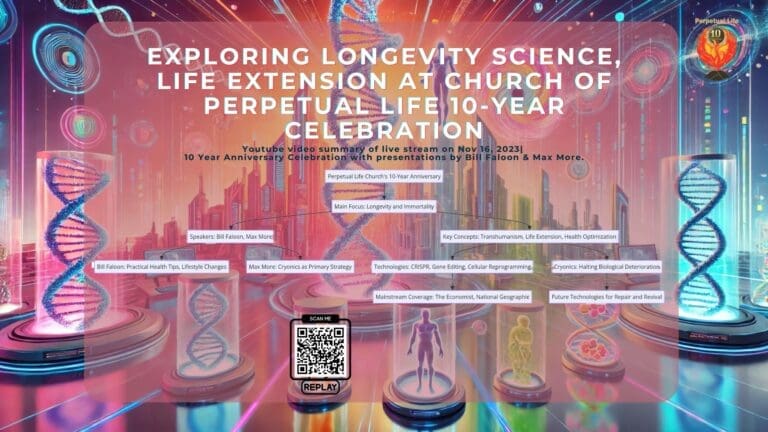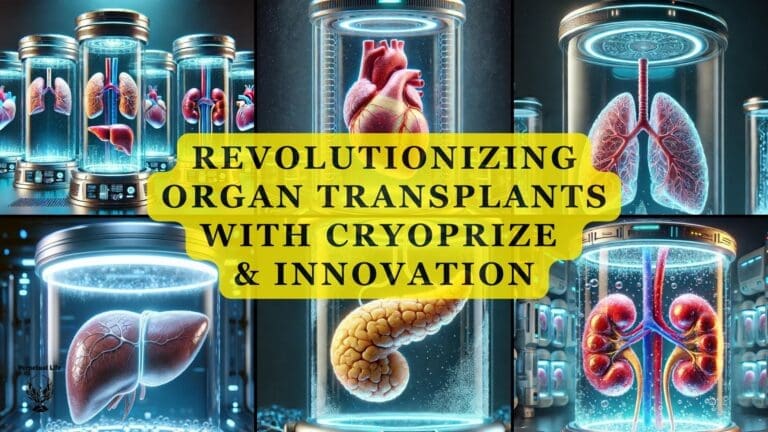Watch our Celebration of James Bedford Day special service. On this day we celebrate the remembrance of the biotechnology self-experimenter, Dr. James Bedford, who, on January 12, 2024, will have been cryonically preserved for 57 years.
Ben Best presents “Updates on Covid-19 and Cryonics Research.” The City of Hollywood has recognized January 12th officially as Bedford Day. Ben Best is a professional health science journalist, and his education includes degrees in Pharmacy, Physics, and Computing Science.
About Dr. James Bedford: James Hiram Bedford (April 20, 1893 – January 12, 1967) was an American psychology professor at the University of California who wrote several books on occupational counseling. He is the first person who was cryopreserved after legal death and remains suspended at the Alcor Life Extension Foundation, awaiting reanimation.
Summarize by Summarize.tech
Summarize transcription:
00:00:00 – 01:00:00
During the YouTube video titled “Updates on COVID-19 and Cryonics Research” with Ben Best on James Bedford Day, the discussion revolves around various topics including the technical explanation of the SARS-CoV-2 virus, emerging COVID-19 variants, Long COVID-19 risk factors, and COVID-19 vaccine safety. Ben Best, a well-known advocate for cryonics and life extension, provides updates on cryonics research, including cryoprotectant use, kidney preservation, and automation in cooling methods. The importance of medical alert systems for cryonic preservation is also emphasized. The video further covers plans for assisted suicide for cryonic suspension and finding less toxic compounds for cryopreservation. Upcoming research beyond 2024 includes perfecting kidney transplants and opening the blood-brain barrier in cryopatients. The section concludes with praise for Ben’s presentation and an announcement of an upcoming event featuring Jose Cordo
- 00:00:00 In this section, the speaker acknowledges the celebration of “Bedford Day” in honor of James Bedford, the first person to be cryonically preserved, and invites viewers to join an event later this month featuring Jose Cordo. Ben Best, a well-known advocate for cryonics and life extension, is introduced as the presenter for the night, coming in from Honduras. Best is a former president of The Cryonic Institute and holds degrees in pharmacy, physics, computer sciences, and finance. He is currently traveling the world attending age reversal conferences and meeting with researchers. Before getting into Ben’s main topics of updates on COVID-19 and cryonics research, the speaker takes a moment to remember James Bedford, the first person to be cryonically preserved, who has been in liquid nitrogen storage for 57 years since his death in 1967
- 00:05:00 In this section of the YouTube video titled “Updates On COVID-19 and Cryonics Research” with Ben Best on James Bedford Day, Ben provides a technical explanation of the SARS-CoV-2 virus, specifically focusing on the spike protein and its attachment to the ACE2 receptor in the human body. He describes how the viral S1 Spike binds to the ACE2 receptor in the lungs and upper respiratory tract, allowing the virus entry into the cells. Ben also mentions the role of TMPRSS2 in virus entry and the potential impact of ACE2 receptor decline with age, diabetes, and cardiovascular disease on virus transmissibility. The conversation then moves on to discuss the timeline and variants of the SARS-CoV-2 virus, starting with the initial Wuhan strain and its mutation to the more transmissible D614g variant in early 2020
- 00:10:00 In this section of the “Updates on COVID-19 and Cryonics Research” video on James Bedford Day, Ben Best discusses the emerging COVID-19 variants, specifically focusing on the alpha, beta, and delta strains, and their mutations throughout 2020. He explains how the omicron variant, which emerged in November 2021, is significantly different from the previous strains, causing less severe disease but spreading more easily, leading to a larger number of infections. Ben also mentions recent emerging subvariants, such as jn1, and the ongoing variation of the BA.2 lineage. The discussion highlights the immune system’s response to these viral changes and their implications for the severity and prevalence of long COVID symptoms. Despite the cleared virus no longer being present in the bloodstream, damage persists in various organ systems, leading to ongoing health challenges for some individuals
- 00:15:00 In this section of the “Updates On COVID-19 and Cryonics Research” video, Ben Best discusses various risk factors for Long COVID-19, including abnormal calcium fluid, hypothyroidism, heavy alcohol use, high blood pressure, and sleep issues. He mentions that only 12% of vaccinated people get Long COVID-19, and the UK survey found that the Omicron variant is half as prevalent for Long COVID-19 as the Delta variant. Best then delves into the controversy surrounding COVID-19 vaccines, explaining how traditional vaccines target multiple epitopes, while mRNA vaccines like Pfizer and Moderna target only the spike protein. As of December 2023, approximately 14 billion vaccines have been delivered globally, with 70% of the world’s population receiving at least one dose
- 00:20:00 In this section of the YouTube video titled “Updates On COVID-19 and Cryonics Research” with Ben Best on James Bedford Day, the discussion revolves around the safety and effectiveness of COVID-19 vaccines and possible side effects. The speaker mentions that while the number of adverse reactions per million doses administered is relatively small, severe cases of anaphylaxis and other conditions including thrombotic events, excess clotting, bleeding, inflammation, heart muscle problems, and stroke have been reported. However, the speaker emphasizes that these incidents are rare compared to the number of vaccines distributed. The conversation then turns to the protective effects of the booster shots against the Omicron variant. It is noted that while the booster shots do not prevent infections or reinfections, they do offer protection against hospitalization and death. The speaker also addresses concerns regarding the mRNA vaccines’ use of IPM (inflammatory myeloid-derived suppressor cells) instead of natural urine, and lipid particles that cross the blood-brain barrier, potentially causing neurodegenerative diseases like Alzheimer’s via the toxic Spike proteins. The speaker acknowledges the controversy surrounding these issues but maintains that the mRNA vaccines have saved millions of lives. Lastly, the video briefly touches on the efficacy of wearing face masks during the pandemic. Initially, Anthony Fauci advised against using masks except for those in high-risk groups, but later changed his stance and recommended universal masking. The speaker cites a Cochrane review stating that surgical masks have not proven effective in reducing the spread of respiratory diseases. However, the speaker mentions alternative methods for prevention and treatment, including regular physical exercise, anti-inflammatory and immune-enhancing supplements, fasting, and quarantine
- 00:25:00 In this section of the YouTube video titled “Updates On COVID-19 and Cryonics Research” with Ben Best on James Bedford Day, Ben Best, the director of research and oversight for the Biomedical Research Foundation (BRF), discusses various research topics related to cryonics. He mentions that Vitamin C, Solium, and omega-3 fatty acids can help resist the inflammatory symptoms of COVID-19, and Paxlovid is a widely used antibio drug that reduces symptoms of the disease. Moving on to cryonics research, Best highlights Raul Goina’s work in Argentina, who is studying the effects of protective agents on the nervous system of the C. elegans worm, which can retain its memories even after being cooled to -80 degrees Celsius. Goina aims to duplicate this research with FAL (fee-assembly line) warming speeds. Tardigrades, known as the ultimate survivors on earth, can survive being boiled in water and cooled to liquidation temperatures, and Goina hopes to train tardigrades to respond to chemical signals and demonstrate their retention after cooling. The 21st Century Medicine organization, which is mostly funded by BRF, aims to preserve organs, such as rabbit kidneys, by cooling them for gene rewarming and transplanting them into a living rabbit with full function. The concept of vitrification is mentioned, which refers to the amorphous, non-crystalline state that occurs when a cool syrup increases viscosity and avoids ice formation, resulting in well-preserved organs that look like they are behind glass, rather than a snowball-like frozen organ
- 00:30:00 In this section of the “Updates on COVID-19 and Cryonics Research” video, Ben Best discusses the potential of preserving human organs, specifically kidneys, at cryogenic temperatures using vitrification. However, the use of cryoprotectants to prevent ice formation can be toxic, creating a challenge. Dr. F as part of Project Renewal Medicine, has been trying to preserve kidneys at sub-zero temperatures, which would meet a great medical need due to organ donor shortages. A breakthrough was made last June in Minnesota, where rat kidneys were vitrified and successfully transplanted back into rats. However, the method used for rat kidneys did not scale up for larger Rapid kidneys. Brian Wowk, who developed the radio frequency rewarming method for kidneys and ovaries, is more penetrating than microwaves and can result in faster warming rates and less cryoprotectant toxicity. Ralph Spindler, leading the rapid brain preservation research, cools and stores brain tissue at around -73 degrees before rewarming and unloading. Another project, Light Microscopy at 20% Medicine, is building an intermediate temperature stabilization system for cryonics
- 00:35:00 In this section of the YouTube video titled “Updates On COVID-19 and Cryonics Research” with Ben Best on James Bedford Day, various updates on cryonics research are discussed. The Cryonics Institute is constructing a European storage unit using Vitreous Ice (VI) for organ preservation, which is less prone to fracturing at higher temperatures. Time Con Medical is planning to scale up their organ fire preservation procedures from rapid kidney preservation to big kidneys. They have discovered new C protective agents with minimal toxicity and aim to demonstrate function, electro function, and Rapid kidney after Alexandre St- Jean has received a grant from the Cryonics Institute to maintain pig brains in a controlled environment, using a technology called Brain X, which allows for faster perfusion and protection studying. Another organization they are funding is Advanced Neurobiological Sciences with Bonnie Wolf as the CEO, using a SyDNS skilled in rat and micro-surgery for cost-effective testing of preservation protocols. They have studied the effects of long-term and short-term warm and cold ischemia, and C Projecting uses carrier solutions that affect the efficacy of PR protection. In 2024, a bill will establish whole brain EG capabilities to assess brain potential after application of C protection. Ash and the Wolf also lead research in improving SST stability transport service and developing liquid ventilation devices. Cooling methods, including ice baths and external circulating cold water, are discussed as ways to reduce ice damage to tissue
- 00:40:00 In this section of the YouTube video titled “Updates On COVID-19 and Cryonics Research” with Ben Best on James Bedford Day, the difference between various cooling methods for cryonic preservation is discussed. Ice bath cooling is slower than ice bag cooling, and internal cooling through liquid ventilation could be even faster. However, it requires surgical access which takes time. The development of an automated liquid ventilation device is underway for standby stabilization transport (SST), a method used when a cryonics patient is dying. During SST, the cryonics team begins cooling the patient, administers medications, and transports them to a cryonics organization for preservation. The organization, Cryonics Institute, currently flies patients from California to their location for these services but is working on local services to reduce travel time. Another organization, Bial Sciences, is expected to offer local services in May 2024. Paranoid Android, another cryonics organization, has had problems and disappointments with preservation in the past, and most of their standby services are for patients dying of cancer or sudden cardiac death. One study showed that 80-64% of all deaths were due to sudden cardiac death, and another study of males aged 45-67 found that 60% of these deaths were due to sudden cardiac death or heart attack
- 00:45:00 In this section of the YouTube video titled “Updates on COVID-19 and Cryonics Research” during James Bedford Day, Ben Best discusses the importance of medical alert systems, particularly for those living alone. He shares stories of cases where individuals were discovered dead several hours after cardiac arrests, emphasizing the need for a rapid detection system. He also mentions the interest of a software developer in implementing a vital signs alarm system that could detect heartbeat, be convenient to use, and transmit messages via phone or email. The conversation then shifts to questions from the live stream audience. One viewer asks about the feasibility of using deactivated viruses for COVID-19 treatments, considering the virus’ rapid mutation; Ben expresses concerns about the potential for new immune responses evading the vaccine. Another question pertains to the use of assisted suicide in countries where it’s legal to help transition willing patients and reduce ischemic damage. Ben notes that organizations like Oregon Cryonics allow this but with the requirement of residency
- 00:50:00 In this section of the YouTube video titled “Updates On COVID-19 and Cryonics Research” with Ben Best on James Bedford Day, topics covered include plans to use assisted suicide for cryonic suspension in Oregon and the Netherlands, the ease of implementation for those wanting a better cryonic suspension, and research being done to find less toxic compounds for cryopreservation, specifically by Greg F from Sweet Repairs in the 21st century. Other plans for cryonic research beyond 2024 include perfecting kidney transplants from pigs and eventually humans, which are the main organs people are dying for due to unavailability. There is ongoing research into opening the blood-brain barrier in cryopatients, and while this is not yet utilized for human cryonic preservation, it is being done routinely with rabbit brains
- 00:55:00 In this section of the YouTube video titled “Updates On COVID-19 and Cryonics Research” with Ben Best on James Bedford Day, Ben discusses the preservation of brain tissue during cryonics and the potential impact of dehydration. He explains that ideal cases of dehydration are rare, and in most cases, the blood-brain barrier is already open. Ben also notes that the damage from dehydration may not be as serious as some people believe, as the brain can be easily rehydrated. Regarding technology, Ben mentions that hardbeat sensation detection has not been added to activity trackers yet, despite requests and predictions for years, and FDA regulations are seen as a major obstacle to advancements in this area. The section concludes with audience comments praising Ben’s presentation and announcing an upcoming event featuring Jose Cordo
01:00:00 – 01:00:00
During the James Bedford Day YouTube event, Ben Best, president of the Cryonics Institute, paid tribute to the song “Forever Young” and the cryonics community’s commitment to defying aging. In his reflection, Best expressed the belief that cryonics has the potential to enable individuals to die young, as per the song’s lyrics, through preserving their bodies after death. He highlighted the continuous advancements in cryonic research, specifically the efforts to enhance the vitrification process for preserving both the brain and the entire body. Despite the challenges and uncertainties, Best maintained a positive outlook on the future of cryonics and the hope it presents for extending human life beyond current limitations
- 01:00:00 In this section of the James Bedford Day YouTube video titled “Updates On COVID-19 and Cryonics Research,” Ben Best, the President of the Cryonics Institute, reflects on the song “Forever Young” during the cryonicsorg’s annual event commemorating the life and legacy of James Bedford, the first person to be cryopreserved in 1967. Ben expresses his belief that cryonics offers the potential to defy aging and die not old but young, as the lyrics of the song suggest. He also mentions the ongoing advancements in cryonic research and technology, and the ongoing efforts to improve the vitrification process for preserving the brain and the entire body. While acknowledging the challenges and uncertainties, Ben remains optimistic about the future of cryonics and the hope it presents for extending human life





